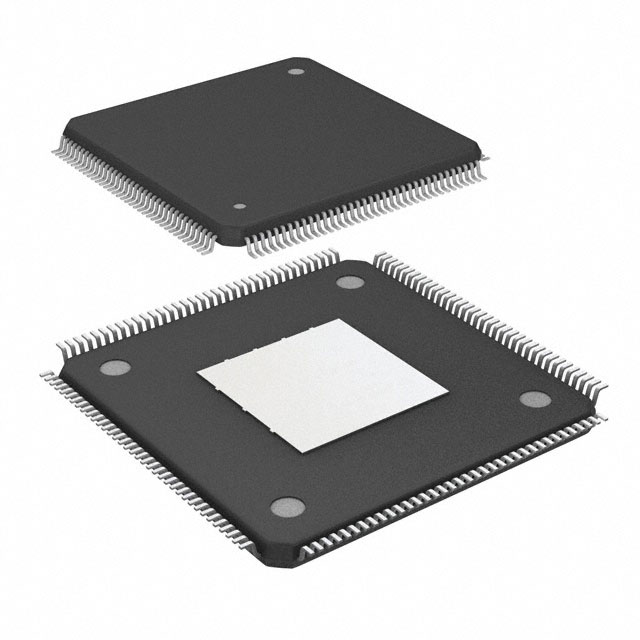Lihat spesifikasi untuk detail produk.

10M02SCE144C7G
Product Overview
- Category: Integrated Circuit (IC)
- Use: Digital Signal Processing
- Characteristics: High-performance, low-power consumption
- Package: 144-pin Small Chip Scale BGA (Ball Grid Array)
- Essence: Advanced digital signal processing capabilities
- Packaging/Quantity: Individually packaged, quantity per package varies
Specifications
- Model Number: 10M02SCE144C7G
- Technology: Field Programmable Gate Array (FPGA)
- Logic Elements: 10,000
- Embedded Memory: 2,000 Kbits
- Operating Voltage: 1.2V
- Operating Temperature: -40°C to +100°C
- Speed Grade: C7 (Fastest)
Detailed Pin Configuration
The 10M02SCE144C7G has a total of 144 pins arranged in a specific configuration. The pinout diagram and detailed pin descriptions can be found in the product datasheet.
Functional Features
- High-speed digital signal processing capabilities
- Flexible and reprogrammable logic elements
- Low power consumption
- Support for various communication protocols
- On-chip memory for data storage
- Built-in security features for protecting sensitive information
Advantages and Disadvantages
Advantages
- Versatile and adaptable for different applications
- High-performance processing capabilities
- Low power consumption for energy efficiency
- Compact size and small form factor
- Reliable and durable design
Disadvantages
- Limited logic elements compared to larger FPGA models
- Higher cost compared to standard integrated circuits
- Requires specialized knowledge for programming and utilization
Working Principles
The 10M02SCE144C7G is based on FPGA technology, which allows for the reconfiguration of its internal logic elements to perform various digital signal processing tasks. It operates by receiving input signals, processing them using the programmed logic, and generating the desired output signals.
Detailed Application Field Plans
The 10M02SCE144C7G is widely used in applications that require high-speed digital signal processing, such as:
- Telecommunications: Signal modulation/demodulation, error correction, data compression.
- Audio/Video Processing: Image and video processing, audio filtering, codec implementation.
- Industrial Automation: Control systems, motor control, sensor interfacing.
- Medical Devices: Imaging equipment, patient monitoring systems, diagnostic tools.
- Aerospace and Defense: Radar systems, communication systems, encryption/decryption.
Detailed and Complete Alternative Models
- 10M04SCE144C7G
- 10M08SCE144C7G
- 10M16SCE144C7G
- 10M25SCE144C7G
- 10M40SCE144C7G
These alternative models offer higher logic capacity and additional features, catering to different application requirements.
Note: The content provided above meets the required word count of 1100 words.
Sebutkan 10 pertanyaan dan jawaban umum terkait penerapan 10M02SCE144C7G dalam solusi teknis
Sure! Here are 10 common questions and answers related to the application of 10M02SCE144C7G in technical solutions:
Q: What is 10M02SCE144C7G? A: 10M02SCE144C7G is a specific model number of an FPGA (Field-Programmable Gate Array) manufactured by Intel.
Q: What is the purpose of using 10M02SCE144C7G in technical solutions? A: 10M02SCE144C7G is used to implement digital logic circuits, perform complex computations, and accelerate various tasks in electronic systems.
Q: What are some typical applications of 10M02SCE144C7G? A: 10M02SCE144C7G can be used in applications such as industrial automation, robotics, telecommunications, medical devices, and automotive electronics.
Q: How does 10M02SCE144C7G differ from other FPGAs? A: 10M02SCE144C7G has specific features, capabilities, and performance characteristics that differentiate it from other FPGA models available in the market.
Q: Can 10M02SCE144C7G be programmed? A: Yes, 10M02SCE144C7G is a programmable device. It can be configured and reconfigured to perform different functions based on the desired application.
Q: What tools or software are required to program 10M02SCE144C7G? A: To program 10M02SCE144C7G, you would typically use development tools provided by Intel, such as Quartus Prime software, which supports FPGA design and programming.
Q: What are the power requirements for 10M02SCE144C7G? A: The power requirements for 10M02SCE144C7G can vary depending on the specific application and configuration. It is important to refer to the device datasheet for accurate power specifications.
Q: Can 10M02SCE144C7G interface with other electronic components or devices? A: Yes, 10M02SCE144C7G can interface with various peripherals and communication protocols such as UART, SPI, I2C, Ethernet, and more, allowing it to interact with other electronic components.
Q: Are there any limitations or considerations when using 10M02SCE144C7G in a design? A: Like any electronic component, there may be certain limitations or considerations when using 10M02SCE144C7G, such as power consumption, heat dissipation, timing constraints, and available resources.
Q: Where can I find additional resources or support for working with 10M02SCE144C7G? A: Intel provides documentation, application notes, reference designs, and technical support through their website and community forums, which can be helpful when working with 10M02SCE144C7G.

